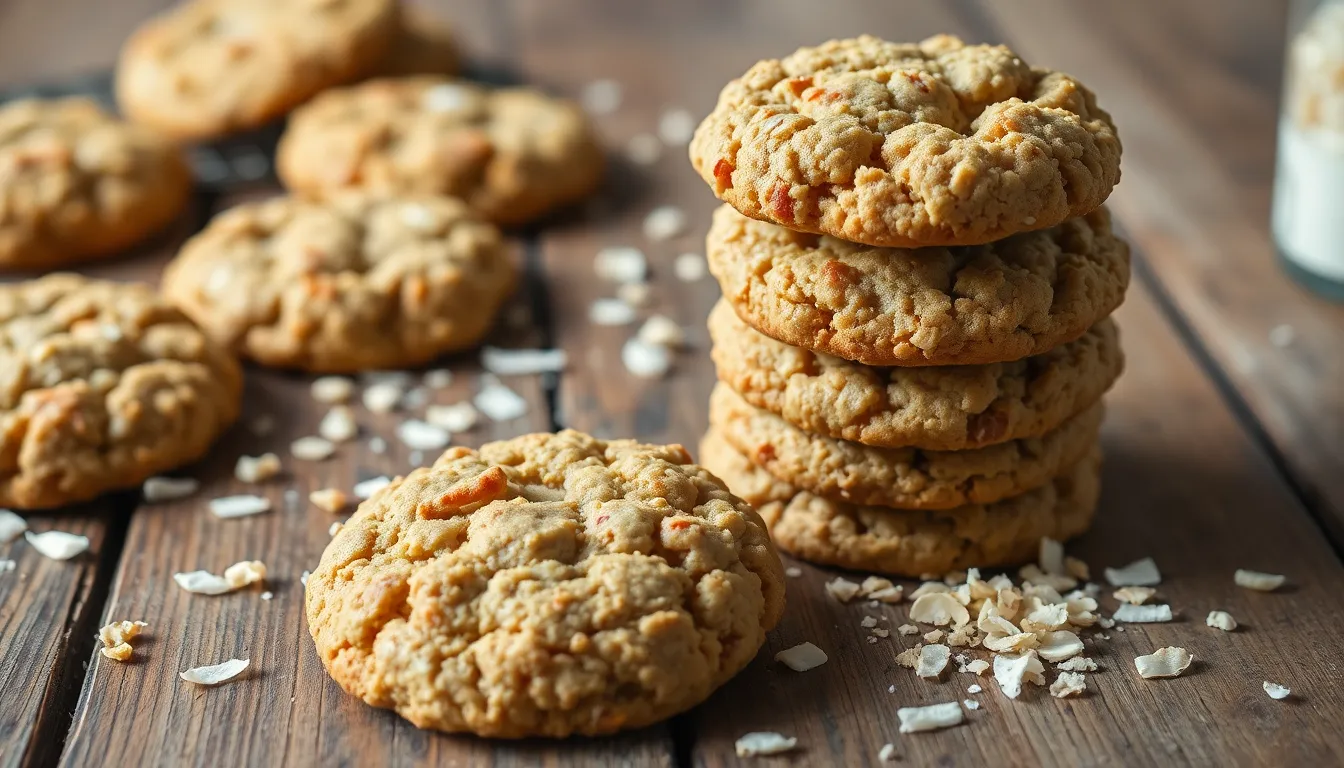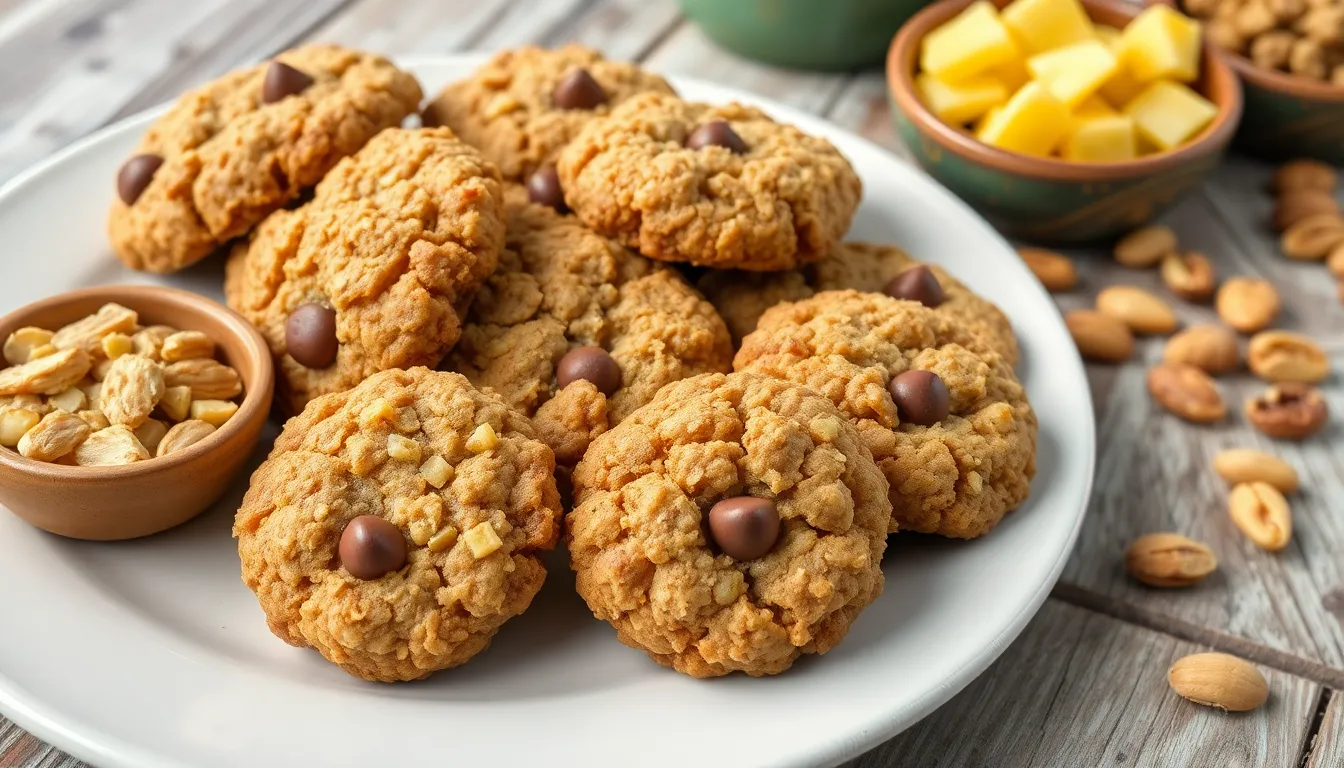We’ve discovered the perfect blend of wholesome oats and tropical coconut that’ll transform your cookie jar forever. These oatmeal coconut cookies combine the hearty texture of rolled oats with sweet coconut flakes to create a treat that’s both satisfying and irresistibly chewy.
What makes these cookies truly special is their incredible versatility. They’re perfect for breakfast with your morning coffee, an afternoon snack, or even a guilt-free dessert. The natural sweetness from coconut perfectly complements the nutty flavor of oats, creating a cookie that’s both indulgent and surprisingly nutritious.
We love how these cookies strike the perfect balance between crispy edges and tender centers. They’re incredibly easy to make with simple pantry staples, and the aroma that fills your kitchen while they’re baking is absolutely divine. Whether you’re a seasoned baker or just starting out, these oatmeal coconut cookies will quickly become your new favorite go-to recipe.
Ingredients
We’ve carefully selected each ingredient to create the perfect balance of texture and flavor in these oatmeal coconut cookies. Our ingredient list features pantry staples that combine to deliver those signature crispy edges and tender centers.
Dry Ingredients
- 1 cup all-purpose flour
- 1 cup old-fashioned rolled oats
- 1/2 cup sweetened shredded coconut
- 1/2 teaspoon baking soda
- 1/2 teaspoon salt
- 1/2 teaspoon ground cinnamon
Wet Ingredients
- 1/2 cup unsalted butter, softened
- 1/2 cup packed brown sugar
- 1/4 cup granulated sugar
- 1 large egg
- 1 teaspoon vanilla extract
Mix-ins
- 1/2 cup mini chocolate chips (optional)
- 1/4 cup chopped walnuts or pecans (optional)
- 2 tablespoons additional coconut flakes for topping
Equipment Needed

We recommend gathering the proper equipment before starting our oatmeal coconut cookie recipe to ensure smooth preparation and consistent results. Having the right tools makes the difference between perfectly baked cookies and disappointing outcomes.
Stand Mixer or Hand Mixer serves as our primary mixing tool for creating the perfect cookie dough. We use this to cream butter and sugars until light and fluffy, which creates the ideal texture foundation for our cookies.
Large Mixing Bowl provides ample space for combining all our ingredients without spillage. We prefer using a bowl that’s large enough to accommodate the full batch while allowing room for thorough mixing.
Rubber Spatula becomes essential for scraping down the sides of our mixing bowl throughout the process. We use this tool to ensure every bit of butter and sugar gets properly incorporated into the dough.
Whisk helps us combine our dry ingredients evenly before adding them to the wet mixture. We whisk together flour, baking soda, and salt to distribute the leavening agent uniformly.
1 Ounce Scoop creates uniform cookie portions that bake evenly and look professional. We recommend this exact size because it produces cookies that are perfectly sized for serving and sharing.
Sheet Pan and Cooling Rack work together for the baking and cooling process. We use the sheet pan for baking and transfer our finished cookies to the cooling rack to prevent soggy bottoms.
Parchment Paper or Silicone Mat lines our baking sheets to prevent sticking and ensure easy removal. We prefer parchment paper for its convenience, though silicone mats work equally well for repeated use.
Small Skillet offers an optional enhancement for toasting nuts like walnuts before adding them to our dough. We toast nuts briefly to intensify their flavor and add extra crunch to our finished cookies.
Instructions

These step by step instructions will guide you through creating perfectly balanced oatmeal coconut cookies with crispy edges and tender centers. We’ll break down the process into manageable stages to ensure consistent results every time.
Prep
We start by preheating our oven to 350°F (175°C) and lining our baking sheets with parchment paper or greasing them lightly. In a medium bowl, we whisk together 1½ cups all-purpose flour, 1 teaspoon baking soda, and ½ teaspoon salt until evenly combined. This dry ingredient mixture forms the foundation of our cookie structure. We set this bowl aside while we prepare our wet ingredients and ensure all our ingredients are at room temperature for optimal mixing.
Mix the Dough
In our large mixing bowl, we beat the softened butter with both granulated sugar and brown sugar using our mixer until the mixture becomes light and creamy, typically taking 3 to 5 minutes. We add eggs one at a time to this creamed mixture, beating well after each addition to ensure proper incorporation. Next, we stir in the vanilla extract until evenly distributed throughout the mixture. We gradually add our prepared dry ingredients to the wet mixture, mixing on low speed until just combined to avoid overworking the dough. Finally, we fold in the rolled oats and shredded coconut using our rubber spatula, stirring until these ingredients are evenly distributed throughout the dough.
Shape the Cookies
Using our 1-ounce scoop or a tablespoon, we portion the dough into uniform balls for consistent baking. Some bakers prefer rolling each dough ball in granulated sugar at this stage for added texture and sweetness on the cookie surface. We place these shaped dough balls on our prepared baking sheets, spacing them 1.5 to 2 inches apart to allow for proper spreading during the baking process. This spacing prevents the cookies from merging together and ensures even heat circulation around each cookie.
Bake
We bake our shaped cookies for 8 to 12 minutes, watching carefully for edges that become lightly browned and set while the centers remain soft to the touch. Baking times may vary depending on your oven characteristics and the size of your cookies, so we monitor them closely during the final few minutes. Once baked to perfection, we let the cookies cool on the baking sheet for 1 to 2 minutes before transferring them to a wire rack to cool completely. This brief cooling period on the hot pan helps set the cookies while preventing them from breaking during transfer.
Directions for Perfect Results

Following these professional techniques will ensure your oatmeal coconut cookies turn out perfectly every time. We’ve tested these methods extensively to help you achieve bakery-quality results in your own kitchen.
Achieving the Right Texture
Temperature control plays a crucial role in determining your cookies’ final texture. We recommend baking at 375°F for 9-10 minutes when you want crispy edges paired with a chewy center. Lower the temperature to 350°F and bake for 8-10 minutes if you prefer soft and chewy cookies throughout.
Sugar composition directly impacts texture development. We combine white and brown sugar to create the perfect balance of crispness and chewiness. Brown sugar adds moisture and creates a tender interior while white sugar promotes browning and crisp edges.
Oat selection matters significantly for texture preferences. Quick oats produce a chewier result since they break down more during baking. We often use a mixture of quick oats and rolled oats to achieve both textures in a single cookie. Rolled oats alone create more distinct oat pieces and a heartier bite.
Preventing Cookies from Spreading
Chilling the dough prevents excessive spreading during baking. We refrigerate our cookie dough for at least 30 minutes before shaping and baking. This step allows the fats to solidify and helps cookies maintain their intended shape.
Sugar quantities require careful measurement to control spread. Excessive sugar causes cookies to spread more than desired during the baking process. We measure our sugars precisely using the scoop and level method for consistent results.
Oven temperature accuracy ensures proper cookie structure development. We verify our oven temperature with a separate thermometer since incorrect temperatures affect how cookies bake and spread. Preheating the oven completely before baking also prevents uneven spreading patterns.
Storage Instructions

Proper storage keeps our oatmeal coconut cookies fresh and delicious for days after baking. We recommend storing these treats at room temperature in an airtight container to maintain their perfect texture and flavor.
Room Temperature Storage
Our freshly baked cookies stay at peak quality when stored at room temperature for up to one week. We store them in an airtight container to prevent moisture absorption and maintain that ideal balance of crispy edges and tender centers. For optimal taste we suggest enjoying the cookies within the first 2 to 3 days when their flavors are most vibrant.
| Storage Method | Duration | Quality Notes |
|---|---|---|
| Room Temperature | 4-7 days | Best consumed within 2-3 days |
| Frozen (baked cookies) | 2-3 months | Texture may slightly change |
| Frozen (cookie dough) | 3 months | Bake directly from frozen |
Freezing Options
We can extend the life of our cookies significantly through proper freezing techniques. Baked cookies freeze beautifully for up to 3 months when we wrap each cookie individually in plastic wrap or parchment paper before placing them in freezer bags. This method prevents the cookies from sticking together and makes it easy to grab just a few at a time.
Cookie dough freezes exceptionally well and offers us the convenience of fresh baked cookies anytime. We shape the dough into balls and freeze them on a baking sheet before transferring to freezer bags. When we’re ready to bake we can place the frozen dough balls directly on our prepared baking sheets and add 2 to 3 extra minutes to the baking time.
Make Ahead Tips
Planning ahead becomes simple when we prepare our cookie dough in advance. We can store covered cookie dough in the refrigerator for 2 to 3 days before baking. This technique actually improves the flavor as the ingredients have time to meld together.
We layer frozen cookies between sheets of parchment paper in our freezer bags to prevent sticking and make removal easier. Using airtight containers for room temperature storage prevents our cookies from absorbing odors and moisture from the surrounding environment.
Make-Ahead Tips

We love preparing these oatmeal coconut cookies ahead of time to save effort during busy weeks. Planning ahead transforms our baking routine and ensures fresh cookies are always within reach.
Refrigerating Cookie Dough
Cookie dough benefits from a rest period in the refrigerator. We store our prepared dough covered tightly for up to 48 hours before baking. This resting time allows the oats to absorb moisture from the wet ingredients while the flavors meld together beautifully. The dough becomes easier to handle and produces cookies with better texture and enhanced taste.
Freezing Cookie Dough
Our oatmeal coconut cookie dough freezes exceptionally well for up to 3 months. We portion the dough into individual cookie balls and place them on a parchment-lined baking sheet. After freezing solid for about 2 hours we transfer the dough balls to freezer-safe bags or containers. Baking frozen dough requires adding 1 to 2 extra minutes to the original baking time without thawing first.
Storing Baked Cookies
Freshly baked cookies maintain their quality when stored properly in airtight containers for several days at room temperature. We place cooled cookies between layers of parchment paper to prevent sticking. The containers preserve the cookies’ soft texture and coconut flavor for optimal enjoyment throughout the week.
Make-Ahead Storage Timeline
| Storage Method | Duration | Best Quality Period |
|---|---|---|
| Refrigerated dough | Up to 48 hours | 24-48 hours |
| Frozen dough | Up to 3 months | First 2 months |
| Room temperature cookies | Up to 1 week | First 2-3 days |
| Frozen baked cookies | 2-3 months | First 2 months |
Preparation Strategy
We recommend making double batches of dough when time permits. Half the dough can be baked immediately while the remainder gets frozen for future use. This approach provides fresh cookies today and convenient options for unexpected guests or sweet cravings later.
Variations

Our oatmeal coconut cookies serve as the perfect base for countless delicious adaptations. These creative variations allow you to customize the recipe to match your taste preferences or dietary needs.
Chocolate Chip Addition
We love incorporating mini chocolate chips into our oatmeal coconut cookie dough for an irresistible sweet indulgence. The rich chocolate pieces complement the nutty oats and tropical coconut perfectly, creating layers of flavor and texture in every bite. Add 1 cup of mini chocolate chips during the final mixing stage, folding them gently into the dough along with the oats and coconut. Dark chocolate chips provide a sophisticated contrast to the sweet coconut, while milk chocolate chips offer a milder, creamier taste that appeals to all ages.
Tropical Twist
Transform our basic recipe into a vacation-inspired treat by improving the tropical flavor profile with additional ingredients. We recommend adding ½ cup of chopped macadamia nuts for buttery richness and ⅓ cup of dried pineapple pieces for tangy sweetness. Toasted coconut flakes intensify the coconut flavor, so consider toasting your shredded coconut in a dry skillet for 2-3 minutes before adding it to the dough. A teaspoon of lime zest brightens the entire cookie, while a pinch of ground ginger adds warmth and complexity to complement the tropical elements.
Gluten-Free Option
Our oatmeal coconut cookies adapt beautifully to gluten-free diets with simple ingredient substitutions. Replace the all-purpose flour with a 1:1 gluten-free flour blend that contains xanthan gum for optimal texture and structure. Ensure your oats are certified gluten-free, as regular oats may contain cross-contamination from wheat processing facilities. The cookies maintain their delightful chewy texture and rich flavor when made gluten-free, making them accessible to everyone at your table. We suggest adding an extra tablespoon of flour if the dough appears too soft, as gluten-free flours sometimes absorb moisture differently than traditional wheat flour.
Conclusion
These oatmeal coconut cookies have everything we love in a homemade treat – they’re simple to make yet deliver incredible flavor and texture. With basic pantry ingredients and foolproof techniques we’ve shared you’ll have warm cookies ready in under 30 minutes.
The beauty of this recipe lies in its flexibility. Whether you prefer them soft and chewy or crispy around the edges our temperature tips ensure perfect results every time. The make-ahead options mean you can always have fresh-baked cookies ready for unexpected guests or weekend cravings.
We’re confident these cookies will become a staple in your baking repertoire. The combination of wholesome oats and tropical coconut creates a satisfying treat that works for any occasion – from casual snacking to special celebrations.
Frequently Asked Questions
What ingredients do I need to make oatmeal coconut cookies?
You’ll need pantry staples including all-purpose flour, rolled oats, shredded coconut, butter, white and brown sugar, eggs, vanilla extract, baking soda, and salt. Optional mix-ins like mini chocolate chips or chopped nuts can enhance flavor and texture. These simple ingredients create delicious cookies with crispy edges and tender centers.
What temperature should I bake oatmeal coconut cookies?
Bake at 350°F (175°C) for soft and chewy cookies, or 375°F for cookies with crispy edges and chewy centers. Bake for 8-12 minutes until edges are lightly browned but centers remain soft. Always verify your oven temperature with a thermometer for consistent results.
How long do oatmeal coconut cookies stay fresh?
Store cookies in an airtight container at room temperature for up to one week, with best flavor within the first 2-3 days. For longer storage, freeze baked cookies for 2-3 months or freeze cookie dough for up to 3 months for fresh-baked cookies anytime.
Can I make the cookie dough ahead of time?
Yes! Refrigerate cookie dough for up to 48 hours to enhance flavor and texture as oats absorb moisture. You can also freeze portioned cookie dough balls for up to 3 months. Making dough ahead saves time during busy weeks and allows for fresh cookies whenever desired.
What equipment do I need to make these cookies?
Essential equipment includes a stand or hand mixer, large mixing bowl, rubber spatula, whisk, 1-ounce scoop, sheet pan, and cooling rack. Use parchment paper or silicone mats to prevent sticking. A small skillet is helpful for toasting nuts before adding to the dough.
How can I customize oatmeal coconut cookies?
Add mini chocolate chips for sweetness, incorporate tropical flavors with macadamia nuts and dried pineapple, or make them gluten-free by substituting all-purpose flour with a gluten-free blend. These variations enhance flavor and texture while accommodating different dietary preferences and taste preferences.
Why are my cookies spreading too much during baking?
Prevent spreading by chilling the dough before baking and measuring sugar accurately. Use the correct sugar ratio of white and brown sugar for proper texture. Also ensure your oven is at the correct temperature, as too-low heat can cause excessive spreading.
Should I use quick oats or rolled oats?
Use rolled oats for better texture and bite. Quick oats will create a different texture that’s less chewy. Rolled oats maintain their shape better during baking and provide the classic oatmeal cookie texture that pairs perfectly with coconut flakes.







